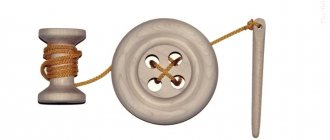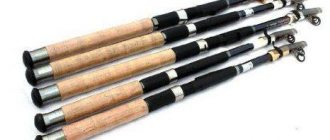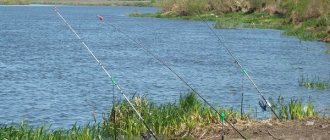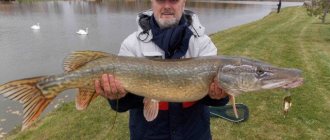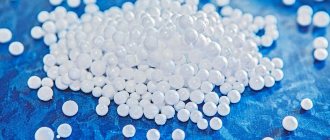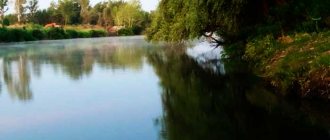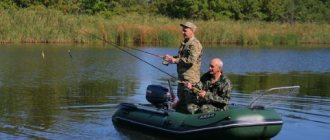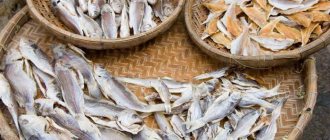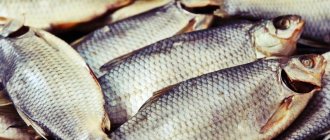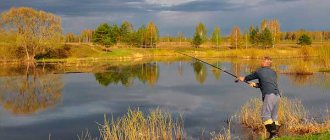Types and classification
First, let's give a basic definition. In fishing, bait is what you equip a fishing rod with to attract fish. It can be placed on the hook of a float or bottom tackle, or it can be an independent technical solution for spinning or fly fishing.
Attention! The whole variety of baits can be divided into two large categories: natural and artificial.
Natural ones, in turn, are usually classified in two directions:
- nozzles of plant origin;
- bait - objects of the animal world.
Artificial baits are most often classified according to the following areas:
- spinning;
- fly fishing;
- for sheer luster;
- for winter fishing.
Let's consider the most popular of them, and give characteristics according to several criteria:
- according to seasonality of use;
- by type of fish;
- according to the type of reservoir on which they are used.
Where is fishing prohibited?
You can find out in detail where fishing is prohibited from the relevant laws. For example, from the federal law “On Fisheries” FZ-No. 166. This is the main document regulating amateur fishing, however, it is not the only one. Specific rules and regulations for fishing are established at the regional level. Rosrybolovstvo regulates production in Russia.
- Important! Recreational fishing is free and free throughout Russia.
Places where fishing is allowed:
Fishing is allowed everywhere (during those periods) where it is not prohibited. That is, in public water bodies that are not nature reserves, private facilities, fish breeding enterprises or other places included in the above list. On commercial ponds, fishing is possible if the owners provide such a service for a fee according to the rules established by the farm.
Places where fishing is prohibited:
- near bridges, locks, dams and hydraulic structures;
- near hatchery fish and cages for raising young animals;
- on river fairways from a watercraft (boat, cutter);
- protected areas (protected areas, reserves, fish hatcheries);
- in pond fish farms;
- where fish spawn during spawning;
- at fish hatchery facilities during the release of young fish.
Before you go fishing, you need to find out whether it is possible to fish in this place. In spring, you also need to remember about fish reproduction - during this period the rules become stricter, up to a complete ban on fishing.
They are established by territorial authorities. You can find out about them on regional websites, in fishing societies, etc. The existing requirements can be reduced to several basic ones.
Main restrictions:
- prohibition of fishing in specific places and for certain periods;
- prohibition of mining of protected species;
- minimum size or weight preventing the prey of juveniles;
- face or boat fishing quotas;
- restrictions on the use of river or sea vessels in fishing (by size, type) or their complete ban;
- regulation of gear (by type, quantity, method of use);
- establishing fees (payment) for legally caught fish (aquatic life).
Natural
Natural, or natural, baits are mainly used for catching peaceful fish, especially plant baits.

This variety includes not only agricultural products, but also products made from them.
Nozzles
We will build the order of consideration of plant attachments according to the principle from simple to complex.
Cereal grains
The simplest bait that fish bite on are grains of various plants, mainly cereals. The most commonly used ones are:
- wheat;
- oats;
- peas;
- corn.
Due to the fact that the grains themselves are hard, do not stick well to the hook and are too tough for the fish, they are pre-prepared: steamed, boiled or fermented. These methods not only soften the shell, but also make the baits more attractive.
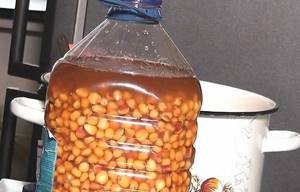
Fermented corn is especially loved by carp in the lake and carp in the river.
Cereals
After the grain has undergone some processing, it turns into cereal or flour. The first option, when boiled, is an excellent bait. In this regard, we note the two most popular of them, which can be excellent fishing:
- pearl barley;
- oatmeal.
Both on the lake and in the river, you can catch almost all white fish with these grains: both large and small.
Dough
Dough is prepared from cereal and legume flour using various additives. This nozzle is good for its plasticity and ability to absorb almost all ingredients, both flavoring and aromatic.
When kneading the dough add:
- vegetable oil;
- honey;
- eggs;
- milk;
- spices;
- artificial flavors;
- dyes.
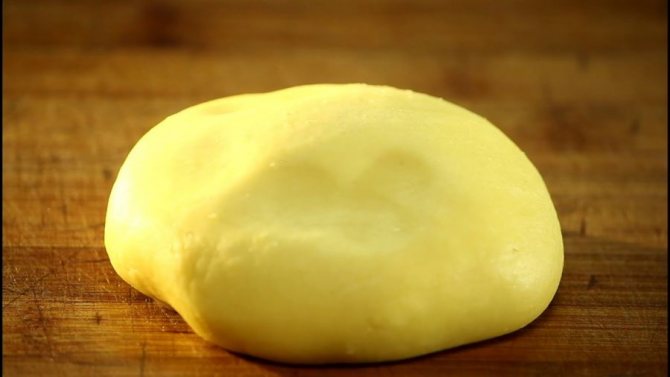
Almost every fisherman has his own “signature” recipe for catchy dough.
Semolina chatter
A special attachment is a mash of semolina with water. It turns out to be aromatic in itself, tempting the fish. If you add a little garlic to it when fishing in cold water in spring or autumn, then all the crucian carp will be yours.
Attention! For the convenience of equipping a hook with a talker, a medical syringe without a needle is used. Squeezing the mass out of it, it is gradually wrapped around the fore-end and hooked with the beard.
Bread and other baked goods
Peaceful fish also bite well on various baked goods:
- white and black bread;
- pancakes;
- homemade baked goods.
Moreover, they can be used as attachments in two ways. In the first case, torn pieces of bread in a shapeless form are put on the hook.

The bread bait "pinch" is especially to the taste of fish with soft lips, such as crucian carp.
The second method involves kneading the crumb and crust with water and various additives, which turns the baked goods into a kind of dough. In this case, the hooks are equipped with rolled balls of such an attachment.
A wonderful bait for spring and summer fishing is maggot
In the spring, after the ice melts from the reservoirs, the water becomes cloudy due to the flood, and at this time fish bite wonderfully on maggots.
Maggot color
The larvae are white, so fish can easily see them underwater. And these larvae smell very attractive. Non-predatory fish such as crucian carp and bream readily take this bait.
Number of maggots on hook
If it bites, then the fishing will definitely be successful. Different fish require different amounts of bait: for crucian carp 1 larva will do, and for bream - 4-5 pieces on one hook.
Storing maggots
Maggots should be stored in a box with sawdust, preferably in the refrigerator. In addition, the box lid must be well closed.
Artificial baits
We call artificial baits that are not found in nature, but are made by man.
The widest range of decoys is used in spinning fishing. We also include the trolling direction here.
Spoons
The oldest of the spinning lures are undoubtedly spoons, with spoons clearly holding the palm.
This simplest snag is a metal plate, bent in a clever way, equipped with a soldered or hanging hook. During wiring, it produces special vibrations in the water that are attractive to predators, which is why it got its name.

A jig for sea fishing is essentially a special case of a jig.
The second type of spinner is a spinner. It was a continuation of the development of the spinner, which had a body - a core, and a rotating petal, which gave the name to the bait.
The vibrations when moving a rotating spoon are slightly different from those produced by a spoon, so it is possible to catch fish that today like other waves.
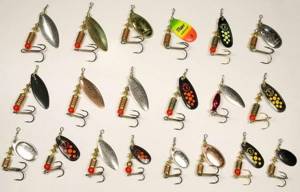
In stagnant water, spinners with rounded petals work better, in currents - with elongated, so-called willow leaves.
I would like to highlight one more type of spinners. In essence, this is the same vibrator, but obtained by an oblique cut from a metal rod. Based on the name of the popular model, they are called castmasters. They are mainly used for hunting white predators - asp and chub.
Winter spinners are also a kind of spoons, only working in a vertical plane. They can be equipped with a pair of hooks – on the top and bottom of the body.
Wobblers
This bait is an imitation fish. Currently they are made of plastic, although prototypes were made of wood or bark. Wobblers are equipped with one or more hanging tees.
Inside the body of the wobbler there is often a chamber in which various types of weights are placed to stabilize and create a sound effect. Many models are equipped with blades, the angle and size of which affect the depth of the bait when retrieving.
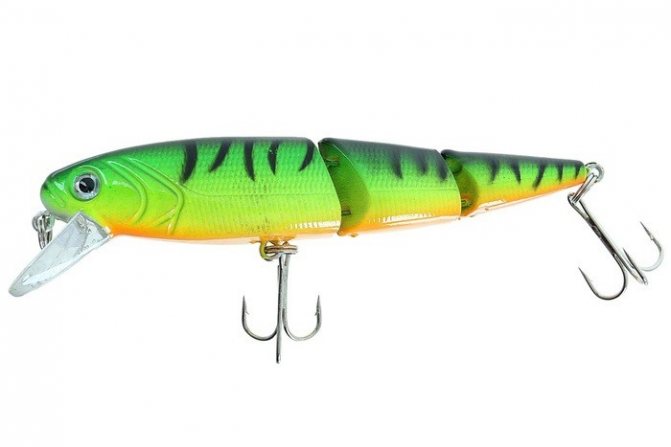
Some wobblers have a body made up of several elements. When retrieving, this gives a more realistic imitation of a live fish.
Soft baits
For jigging with a spinning rod, during winter fishing and when fishing vertically, soft baits are used. They are equipped with jig heads, as well as offset hooks or doubles in combination with an eared sinker - Cheburashka.
On a note! Such baits are also used in fishing with spaced jig rigs.
Made from:
- foam rubber;
- rubber;
- silicone.
Recently, so-called edible rubber has become widespread - silicone impregnated with attractants.
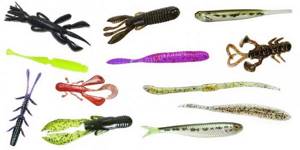
Silicone baits are inexpensive, so they are widely used among fishermen.
Front sights
Flies are used to catch predators using fly fishing. They are made on the basis of a fishing hook by attaching various natural and synthetic materials to it. Depending on their weight, they are divided into two categories:
- dry - for driving on the surface of the water;
- wet - for working under water.

The fly should remind the predator of some familiar or fancy insect.
Fishing on the river for predatory fish.
Fishing on the river from a boat.
To fish on the river, a fisherman needs a spinning rod - second or third class, with a long handle. If fishing is carried out in places or areas with a rocky bottom, where hooks become dull very quickly, you need to have a sharpening tool with you, I usually take a diamond needle file with me. In order not to tire yourself when lifting a load (anchor) frequently, you can develop a special buoy.
Be sure to take a landing net with you into the boat. Without it, it will be difficult to pull large fish into the boat. And one more thing, when fishing from a boat, take some kind of bag or large dense bag with you. Place the caught fish in it so that it does not jump all over the boat. If you are fishing for pike, be sure to use metal leashes. The pike instantly saws through fishing line or braid with its sharp teeth. The length of such leashes should be 130-150 mm.
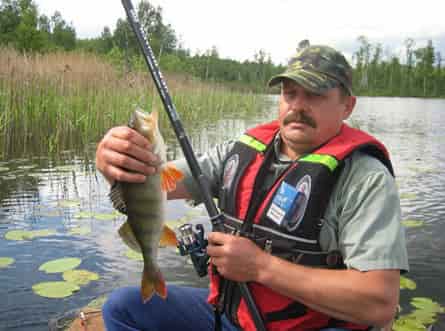
Fishing on large rivers has its own specifics - you need to know the bottom topography and its features. It is best to walk around the water area with an echo sounder before fishing and remember or write down the areas for fishing. If you find a drop from deep water to shallow water, the so-called drop, this is the most promising area for fishing on the river. There will always be predatory fish, pike or pike perch, here.
Also good are places where there are ravines, ditches, roots, and so on. The more places you spot, the more successful your fishing on the river will be. Be sure to pay attention to the times when fish predator activity is most intense. In different parts of the river, pike and pike perch behave differently. Using your echo sounder data and visual observations, you can fish all day on large rivers, just in different areas.
Careful preparation and careful analysis always gives a chance to catch a trophy. When catching a large predator, be it pike, pike perch or catfish, trolling lures are mainly used for fishing from a boat. These are large spoons and wobblers with a diving depth of one and a half meters. If you find an underwater hill (where the depth drops sharply), you should fish it carefully.
This is a kind of feeder for peaceful fish, and, accordingly, for predators. In such a place, large pike perch often sits in ambush. As a rule, the predator stands with its muzzle in the direction of a shallower place. This means that it is worth fishing from the middle of the hill, gradually expanding the fishing radius. This is an interesting specificity of fishing on the river when catching a predator - pike perch or pike.
If you suddenly forgot the landing net, it’s not a problem, because the fish can be pulled into the boat without it. Only your actions in this case should be very careful and there is no need to rush. Bring the fish to the boat itself (for example, at a distance of 38-40 cm) and, without lowering the end of the spinning rod, you need to turn around its axis 2-3 times. After this, the fish completely loses orientation and stops pulling to depth. Now you need to bring the pike or pike perch all the way to the side of the boat and, sitting down, quietly take it under the gills and put it in the boat. On large rivers there is always pike, pike perch, large perch, whitefish, and knowing the places you can catch trophy catfish.
What's the best way to fish?
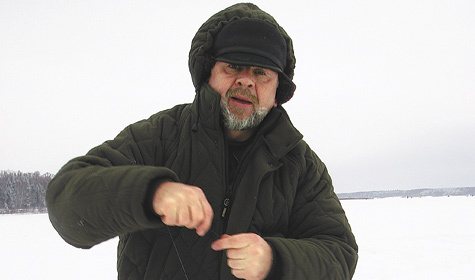
After the euphoria of an excellent bite on the first ice of various fish and on various gears, then practically throughout the entire glaciation period until spring, you have to fish in the conditions of the so-called dead winter, only occasionally interrupted by short bursts of fish activity. Then, in order to entice the fish to bite and achieve a significant fishing result, the fisherman has to go to all sorts of tricks, using the entire arsenal of known gear and knowledge about the habits of underwater inhabitants. But not always and not all anglers during the difficult period of deep winter manage to pick up the keys to an almost asleep fish, and the short fishing time is wasted in search of some illusory “biting formula.” At the same time, there are still more successful fellow hobbyists who sit nearby on the ice and from time to time extract quite worthy trophies from the holes.
Therefore, keeping in mind such successful fishermen, it should be assumed that in any unfavorable situations, fishing can be made quite productive. But for this you will have to firmly grasp certain fishing “axioms”. The main one is this: if the bite is bad, only two main methods of winter fishing can help out - stationary fishing with float tackle or active work with a jig at different depths and throughout the entire water column. And here there is no need to somehow compare or contrast both of these methods, perhaps even showing some disdain for passive sitting near abundantly fed holes. It is much more important to establish a reasonable framework, the limits of applicability of these two approaches in fishing science, depending on the current circumstances, which implies the prospects for catching a particular fish, and the amount of time allotted for fishing, and the capabilities of the fisherman himself and his preferences, and a lot more.
So, another “axiom” says that a skillfully tuned winter float rod is good for catching schooling but inactive fish, for example, bream or roach, when it is possible to introduce competitive discord and excitement into their ranks by throwing a small, only “seed” fish to the bottom. the amount of proven bait that can awaken a fish’s appetite. By feeding carefully and without excess, you will still be able to force the fish to “densify” in some place and begin to feed. The bait on the hook should also look like a free, affordable treat, or at least differ from it as little as possible. And here a float rod is indispensable: one or three larvae of a large bloodworm, which is common in winter, put on a small and thin hook tied to a relatively long leash, slowly sinking to the bottom in a column of falling bait particles, is unlikely to cause fear even in cautious fish.
Of course, not only a bloodworm on a hook can give the desired result: a lot depends on local fishing conditions - somewhere jigs are used en masse, in northern reservoirs a bark beetle larva or a worm is more often used, and in deep and clean sand pits, for example, roach Sometimes it’s better to use a ball of dough, a piece of unsalted lard, or a Chernobyl larva, especially if you periodically pour dry semolina into the hole, which, when wet, slowly sinks to the bottom. By the way, regarding attracting fish to the place of fishing: in reservoirs we almost always observe the same incomprehensible phenomenon - fishermen “feed” the holes under the float rods with stinking small bloodworms obtained in settling tanks, and “drown” them with kilograms, and even in a mixture with “fragrant” silt, and they try to catch it with large and clean lake bloodworms. This issue takes place during a period of active life under water, when the fish, although with disgust, consumes everything that can be eaten. However, in the dead of winter, which, we have to repeat, is most pronounced in early spring, fish often leave places where bait is abundantly filled, worsening the quality of the water, taking away oxygen from it, which is already scarce at the end of winter.
It is much better and much cheaper to stock up for fishing with about 100 grams of large, high-quality bloodworms, mixing it with fresh and adequately moistened breadcrumbs, in which some of the larvae must be crushed, which will ultimately enhance the effect of even a very small portion of such bait, since particles of breadcrumbs will also will begin to “emit” the smell of bloodworms. The amount of bait mixture with large bloodworms with a total weight of 200-300 grams is quite enough to “feed” 4-6 fishing “points” without excess and in an environmentally safe manner and attract fish there. Sometimes it helps if the finished mixture is “refreshed” with a tiny amount of garlic or anise or dill oil, but using flavorings in ice water is a very risky business.
And one more thing - you shouldn’t think that a float rod in winter is only good for deep fishing in the still water of lakes or reservoirs. In addition to these standard conditions, using lightweight equipment, you can successfully catch roach at relatively shallow depths, as well as bleak in mid-water. And in moderate currents, this tackle is quite applicable, only then the load is selected not under the float, but under the force of the flow - here the sinker is lowered to the bottom, a fairly long leash with a hook or a light jig is mounted slightly above it. In this case, the size of the removable float is selected from a pre-prepared set so that it is not pulled under the water by the pressure of the current on the fishing line. However, here it is often easier to replace the float with a guard with variable length and elasticity, and feed the bait using a feeder installed on the bottom, lowering it through a hole drilled 2-3 meters upstream from the gear. In general, a float fishing rod is not so simple; it has different design options depending on the conditions and objects of fishing.
When the fish is dispersed throughout the reservoir and is not responsive to bait or is noticeably distributed vertically in the water column, then the first place comes to a more efficient and sensitive tackle with a jig and a bite alarm in the form of an elastic nod, which also serves as a drive mechanism that can force play artificial bait under water, imitate the behavior of some kind of live food for fish. Often a jig also helps out when deep-fishing the same bream, when it only barely noticeably moves the float and it is difficult to choose the moment for a reliable hook-up. Only in case of such an uncertain bite you will need an extremely small jig with a good hook and only one bloodworm on it, set in a half ring.
Of course, the bait must be tied on the thinnest fishing line - it is clear that with such delicate gear there will be a lot of hassle and fuss while fishing, and it will require considerable dexterity from the fisherman, and careful preparation of the place, which is very important when fishing for the next trophy, but but, albeit slowly, the fishing box will be filled with catch. By the way, the most experienced fishermen find schools of bream in this way: having achieved several bites of decent fish in a certain area with a jig, they immediately lower the bait, designed to collect denser bream and intensify its fishing with a float rod that is already “faster” in these conditions. Thus, success can be achieved here by skillfully combining fishing with both methods - both with a jig and a float rod. However, the same movement or interchangeability of gear is hardly possible when you have to catch perch, ruffe or a larger predator, for example, bersh or pike perch - in this case, gear with a jig will not be equal due to the behavior and bite of this fish.
Anatoly Mailkov January 24, 2014 at 00:00
